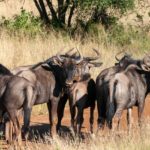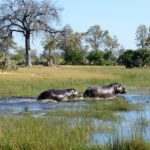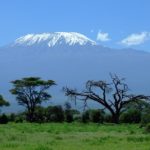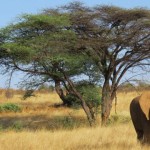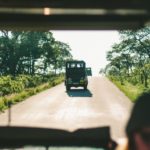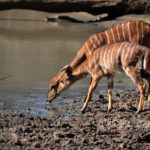A South African’s Take on Diverse African Safaris
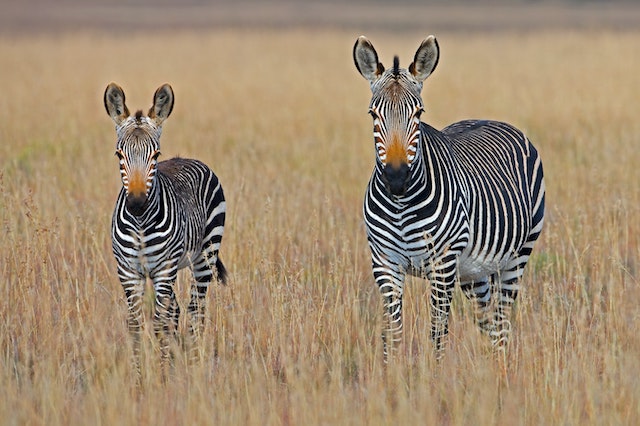
As a native South African and ardent wildlife fanatic, it was an outrageous concept that despite vast travelling experiences, by age 25, I still hadn’t been into the African bush or in a 4X4 vehicle scanning the ‘veld’ for wildlife. As a child, I’d often announced that I wanted to be a zoologist, so the notion of having some sort of affiliation to wildlife always felt natural to me.
In 2011, I embarked on an overland camping safari experience–travelling from Swaziland, through Mozambique, and ending up in the famous Kruger National Park. Despite the rustic nature of the trip, it was on this journey that I really fell in love with all that Africa has to offer–her people , her animals and her magnificent landscape. There really is no place like it.
In daylight, our surroundings were nothing short of breathtaking: two hippopotamuses bathing just feet ahead of us, a herd of elephants sharing the communal drinking spot and majestic rhinos hiding in the bushes nearby.
One year later, I found myself in a slightly more comfortable position–having swapped tents for a hotel, just walking distance from the magnificent Victoria Falls and in complete awe of the world’s largest waterfall, a two kilometer-wide drop in to the Zambezi River.
After countless safaris in Southern Africa, including Zimbabwe, Zambia and Botswana, I wanted to make sure that I’d covered all of my bases, so earlier this year I hiked (and slid) my way through the Bwindi Impenetrable Forest in Uganda in search of the royal but highly endangered gorilla.
These days, a safari can be anything from a camping weekend away, a luxury 5-star experience in the heart of the African bush or an epic cross-country trek, which often includes rare sightings and photo opportunities. It doesn’t matter what sort of safari experience you are interested in; the best part of Africa is that not only is there so much to see and experience but that you can do so in a way that suits your particular travel style. Deciding which is going to suit you best is easier if you look at the many attractions in the various regions.
A South African’s Take on Diverse African Safaris.
I’ll never forget my first wake up in Hlane National Park, Swaziland. After hours at the border crossing, a night without electricity, fumbling to set up tents and the literal roaring of lions nearby, I spent my first night slightly unnerved. But in daylight, our surroundings were nothing short of breathtaking: two hippopotamuses bathing just feet ahead of us, a herd of elephants sharing the communal drinking spot and majestic rhinos hiding in the bushes nearby. Despite the pastoral and rather discomforting first night, the stillness and sheer magnificence of these glorious animals, almost oblivious to our flashing cameras and whispers of excitement were enough to fill my heart with happiness.
The serenity of the African bush is truly defined by its quiet stillness of abundant herds of deer, antelope and zebra nonchalantly going about their daily grazing, herds of elephants and–if you are lucky–a few rhinos and wildebeest making their way to watering holes, the heads of giraffes chewing at leaves and playful monkeys swinging from branches.
When on safari, it is important to remember that no sighting is guaranteed and that every view is a luxury. The animals on a game reserve are not there for your observance, but to exist and survive in their own beautiful world. Scanning the horizon for sightings is often exhilarating but, especially when on the lookout for predators, can be disappointing. As masters of disguise the cats are difficult to spot, but when they meander across the road in front of your vehicle, as they did when I was on a drive in the Kruger, a lioness and her cubs, can truly amaze. You become witnesses to the remarkable existence of these animals.
Victoria Falls should definitely be an essential stop when checking out the wildlife in the national parks of Zimbabwe and Zambia, or any trip to the Southern part of Africa. My trip to this region was filled with more adventurous activities–including walking safaris–both through the bush and subsequently with lion cubs as part of a rehabilitation program.
The highlights however, were the two boat cruises–one being a sunset cruise down the great Zambezi river and the other in the Chobe Game Reserve, Botswana, which is famous for its dense population of elephants. Crocs on riverbeds, hippos lazing in muddy shallow water and elephants going about their daily business are really incredible sights to witness from the water. From a boat, it’s as though you are immersed in the world of the animals.
Whilst I haven’t been fortunate enough to witness the supposed greatest safari of them all–the wildebeest migration in the East African destinations of Kenya and Tanzania and the vast landscape of the Serengeti–it really is just a matter of time before I check it off my bucket list (I am aiming for next year.)
A trip to Africa has everything for every type of traveller: a wide range of accommodation–from five-star luxury lodges to roughing-it camp sites.
Yet, I have had the opportunity to spend an hour in the company of the elusive great apes after a seven-hour trek through dense rainforest. Despite what websites and tour companies might tell you, the walk up the mountain to find these beautiful creatures is tough. It’s muddy and wet and at times you must walk up (or slide down) slopes of almost 90 degrees. The challenge, however many times you swear you’re going to turn around, will no doubt be one of your most worthwhile and humbling safari experiences of your life.
With so many options for safari trips these days, it is essential you decide what you want from your experience. A trip to Africa has everything for every type of traveller: a wide range of accommodation–from five-star luxury lodges to roughing-it camp sites. You get to view wildlife in a host of different ways–on boats, elephant back, horseback, by foot or open air 4×4 jeeps. You can head out at dawn or at sunset and you can engage in cultural community-based projects as well.
Both the Eastern and Southern regions of Africa offer a superb opportunities to witness some of the world’s most incredible creatures.
Which types of African safaris do you recommend?
Photo credit by Unsplash.


